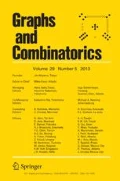Abstract
A color pattern is a graph whose edges have been partitioned into color classes. A family  of color patterns is a Ramsey family provided there is some sufficiently large integer N such that in any edge coloring of the complete graph K
N
there is an (isomorphic) copy of at least one of the patterns from
of color patterns is a Ramsey family provided there is some sufficiently large integer N such that in any edge coloring of the complete graph K
N
there is an (isomorphic) copy of at least one of the patterns from  . The smallest such N is the Ramsey number of the family
. The smallest such N is the Ramsey number of the family  . The classical Canonical Ramsey theorem of Erdős and Rado asserts that the family of color patterns is a Ramsey family if it consists of monochromatic, rainbow (totally multicolored) and lexically colored complete graphs. In this paper we treat the asymmetric case by studying the Ramsey number of families containing a rainbow triangle, a lexically colored complete graph and a fixed arbitrary monochromatic graph. In particular we give asymptotically tight bounds for the Ramsey number of a family consisting of rainbow and monochromatic triangle and a lexically colored K
N
. Among others, we prove some canonical Ramsey results for cycles.
. The classical Canonical Ramsey theorem of Erdős and Rado asserts that the family of color patterns is a Ramsey family if it consists of monochromatic, rainbow (totally multicolored) and lexically colored complete graphs. In this paper we treat the asymmetric case by studying the Ramsey number of families containing a rainbow triangle, a lexically colored complete graph and a fixed arbitrary monochromatic graph. In particular we give asymptotically tight bounds for the Ramsey number of a family consisting of rainbow and monochromatic triangle and a lexically colored K
N
. Among others, we prove some canonical Ramsey results for cycles.
Similar content being viewed by others
Author information
Authors and Affiliations
Corresponding author
Rights and permissions
About this article
Cite this article
Axenovich, M., Jamison, R.E. Canonical Pattern Ramsey Numbers. Graphs and Combinatorics 21, 145–160 (2005). https://doi.org/10.1007/s00373-005-0603-6
Received:
Accepted:
Issue Date:
DOI: https://doi.org/10.1007/s00373-005-0603-6



